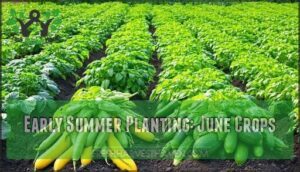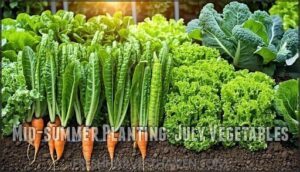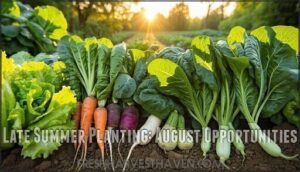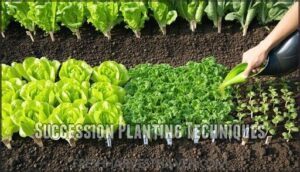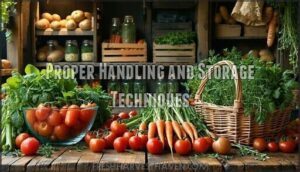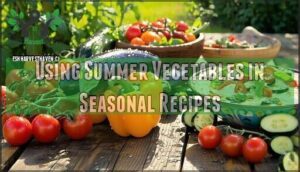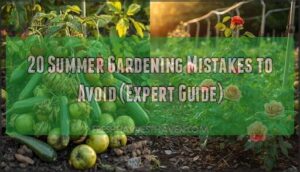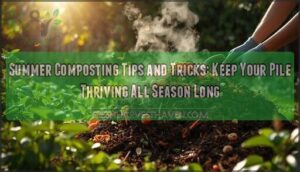This site is supported by our readers. We may earn a commission, at no cost to you, if you purchase through links.
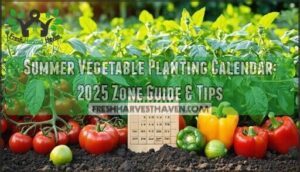
In June, plant warm-season favorites like tomatoes, peppers, and squash after soil warms to 60°F.
July’s perfect for beans, cucumbers, and heat-loving herbs like basil.
August offers last chances for quick-maturing crops like lettuce and radishes in cooler zones, while southern gardeners can still plant okra and eggplant.
Timing matters more than you’d think – plant too early and cool soil stunts growth, too late and summer heat stresses seedlings.
Success comes from matching your local frost dates with each vegetable’s temperature preferences, creating a summer vegetable planting calendar that maximizes your harvest window and ensures proper growth with the right heat tolerance.
Table Of Contents
- Key Takeaways
- Summer Planting Basics
- Month-by-Month Planting
- Maximizing Summer Yield
- Extending Summer Season
- Harvesting Summer Vegetables
- Frequently Asked Questions (FAQs)
- When to start planting summer vegetables?
- What is the best vegetable to plant in summer?
- What vegetables can and cannot be planted next to each other?
- Is mid-July too late to plant vegetables?
- What is a vegetable planting calendar?
- What is a planting calendar?
- When should you plant vegetables?
- Is summer a good time to plant vegetables?
- What vegetables can be planted in summer?
- What vegetables can you plant in September?
- Conclusion
Key Takeaways
- You’ll maximize success by timing your plantings with soil temperature and frost dates – plant heat-lovers like tomatoes and peppers in June when soil hits 60-70°F, not before
- You can extend your growing season using succession planting every two weeks for continuous harvests and late-summer plantings of quick crops like radishes and lettuce in August
- You’ll boost yields significantly through proper spacing (24-36 inches for tomatoes), deep watering 1-2 times weekly, and companion planting strategies like basil with tomatoes for natural pest control
- You should focus on heat-tolerant varieties and use shade cloth or strategic plant placement during extreme heat to keep vegetables productive through scorching summer temperatures
Summer Planting Basics
Summer vegetables need warm soil and the right timing to thrive in your garden.
You’ll get the best results by planting heat-loving crops like tomatoes, peppers, and squash when soil temperatures consistently stay above 60-70°F, which typically happens after your area’s last frost date.
Heat-Loving Vegetables to Plant
When choosing summer vegetables to plant, focus on heat-tolerant varieties that thrive in optimal temperatures between 70-90°F.
Warm season planting champions include tomatoes, peppers, eggplant, and okra, which need soil temperatures above 65°F and night temperatures consistently over 60°F.
Sweet corn handles extreme heat up to 112°F, while green beans demand full sun.
These heatloving crops form the backbone of your summer vegetable planting calendar, perfect for direct sowing once warm conditions arrive.
Optimal Planting Times for Summer Crops
Timing summer crops perfectly transforms your garden from struggling seedlings to thriving harvests.
Your regional calendars and frost dates guide every planting decision, ensuring vegetables flourish in ideal conditions.
Understanding crop-specific timing means knowing that tomatoes need 60°F soil temperatures, while corn tolerates cooler starts at 55°F.
A personalized garden planner helps track these details for your specific zone.
- Early plantings (May-June): Focus on heat-lovers like tomatoes, peppers, and beans after soil warms consistently
- Mid-summer sowings (July): Perfect for carrots, beets, and succession crops that mature before fall frost
- Late opportunities (August): Quick-growing radishes and greens capitalize on remaining warm weather
Your summer planting guide should account for local microclimates and elevation changes that affect ideal planting times by weeks.
Soil Preparation for Summer Vegetables
Strong soil preparation determines your summer vegetable garden calendar success.
Start by conducting nutrient testing to check soil pH levels, which should fall between 6.0-7.0 for ideal growth. Add 2-3 inches of compost amendments to boost organic matter and improve soil structure.
Address drainage solutions by incorporating coarse materials if water pools after rain. Create raised beds that warm faster in spring, giving heat-loving crops an advantage.
Apply mulch depth of 2-3 inches around plants to retain moisture and regulate temperature. These foundation steps transform ordinary dirt into a thriving environment for your summer planting guide success.
To avoid issues, remember to clear debris and rocks before planting.
Companion Planting Strategies
With proper soil ready, smart plant partnerships can transform your garden into a productivity powerhouse.
Companion planting maximizes space efficiency while creating natural pest deterrents that protect your summer vegetable planting calendar.
Smart plant partnerships boost garden productivity while naturally protecting crops from pests.
Companion planting transforms your garden into a harmonious ecosystem, boosting yields while naturally deterring pests and inviting beneficial insects.
The classic Three Sisters method pairs corn, beans, and squash perfectly. Corn provides climbing support, beans fix nitrogen in soil, and squash acts as living mulch.
Interplanting benefits extend beyond space savings – basil planted near tomatoes repels whiteflies, while mixed plantings of carrots and onions disrupt pest cycles.
These intercropping strategies work like nature’s security system, offering pest control without chemicals. Crop rotation planning becomes easier when you understand which plants work together.
Your summer garden becomes more resilient and productive through these strategic partnerships.
Key companion planting combinations:
- Tomatoes with basil for whitefly protection
- Corn, beans, and squash for the Three Sisters method
- Carrots and onions to confuse root pests
- Fast-growing radishes between slower-establishing crops
Month-by-Month Planting
Timing your summer plantings month by month maximizes your harvest and keeps your garden productive through the season.
You’ll plant heat-lovers like tomatoes and peppers in June, root vegetables in July, and quick-growing crops like radishes in August, which are all part of planning for a productive garden with quick-growing crops.
Early Summer Planting: June Crops
June’s warm soil creates perfect conditions for heat lovers like beans, cucumbers, and summer squash.
Your soil temperature should reach 70°F before direct seeding these June vegetables. Plant bush beans every two weeks for continuous harvests, and add basil as companion plants near tomatoes to deter pests.
| Crop | Days to Harvest | Soil Temp Needed |
|---|---|---|
| Bush Beans | 50-60 days | 65°F+ |
| Cucumbers | 50-70 days | 70°F+ |
| Summer Squash | 45-55 days | 70°F+ |
| Okra | 50-65 days | 75°F+ |
| Sweet Corn | 60-90 days | 60°F+ |
Your summer vegetable planting calendar shows June as prime time for establishing these crops before peak heat arrives.
Mid-summer Planting: July Vegetables
July’s heat doesn’t slow your summer vegetable planting calendar.
Root vegetables like carrots, beets, and turnips planted now deliver excellent fall harvests.
Succession planting every two weeks keeps your table stocked through autumn.
Heat-tolerant leafy greens including kale, Swiss chard, and collards thrive with mid-summer starts.
Regional adjustments matter—southern zones handle okra and southern peas well into July.
Pest mitigation becomes critical as cucumber beetles and aphids peak, so consider row covers for tender seedlings.
Consistent watering is key, and succession planting of beans, carrots, and beets guarantees a continuous harvest with succession planting being crucial for a bountiful supply of vegetables, ensuring a thriving garden.
Late Summer Planting: August Opportunities
August’s summer garden calendar offers a second chance for late crops before fall arrives.
August’s second chance can rescue your harvest timeline before frost strikes.
Smart gardeners use these summer planting dates for quick-growing vegetables that’ll beat the first frost.
Your vegetable planting times depend on zone adjustments, so check local frost dates.
These fast growers work perfectly for fall harvest:
- Root vegetables like carrots, beets, and turnips handle cooling temperatures and light frosts beautifully
- Leafy greens including lettuce, spinach, and arugula mature quickly for late-season meals
- Bush beans and summer squash finish producing before harsh weather hits
This summer vegetable guide maximizes your growing season’s potential.
Succession Planting Techniques
Maximize your garden’s potential with staggered planting every two weeks. Plant lettuce, radishes, and beans at regular intervals for continuous harvest throughout summer.
Your timing strategies should include replacing finished crops immediately with new plantings. Seed starting indoors while direct-sown crops mature keeps production flowing.
Track summer planting dates on your calendar to maintain momentum. Smart crop rotation prevents soil depletion while succession planting guarantees you’ll never run out of fresh vegetables.
Plan optimal planting times based on each variety’s maturity date for seamless summer vegetable planting.
Maximizing Summer Yield
You’ll get the most from your summer garden by focusing on proper plant spacing, consistent watering, and smart fertilization timing.
Strategic trellising and pest management will turn your heat-loving crops into productive powerhouses that keep delivering fresh vegetables all season long.
Proper Spacing and Trellising Techniques
Smart spacing transforms crowded gardens into productive powerhouses. Your summer vegetable growing success hinges on giving plants room to breathe, access sunlight, and receive proper airflow benefits.
Here’s your planting schedule summer guide for ideal spacing:
- Tomatoes: Space 24-36 inches apart with 6-foot stakes or cages installed at planting time for maximum sunlight access
- Cucumbers: Plant 12 inches apart on sturdy trellis types reaching 6-8 feet for vertical gardening efficiency
- Peppers: Allow 18-24 inches between plants with lightweight supports to prevent branch breakage
- Pole beans: Position 4-6 inches apart along strong trellises for impressive vertical harvests
- Bush beans: Maintain 3-4 inches in rows without supports for easy maintenance
Proper spacing prevents disease by improving airflow benefits between plants. Consider different cage options to best support your tomato plants.
Cramped vegetables compete for nutrients and sunlight, reducing yields substantially. Your summer garden planting efforts pay off when each plant has adequate space to flourish. The spacing impact becomes obvious as healthy, well-spaced plants outperform their crowded neighbors every time.
Watering and Irrigation Best Practices
Beyond the surface lies your garden’s success—deep watering transforms struggling plants into thriving ones.
Water deeply 1-2 times weekly rather than daily shallow sessions. This watering frequency encourages robust root systems and drought resistance.
Drip irrigation and soaker hoses deliver targeted irrigation methods while conserving water. Consider efficient water distribution for ideal plant health.
Monitor soil moisture by inserting your finger 2 inches down—dry soil signals watering time for perfect summer vegetable growing.
Fertilization Schedules for Summer Crops
Well-watered vegetables need proper nutrition to thrive.
Start fertilization schedules with soil testing to determine your garden’s specific needs.
Apply balanced fertilizer at planting, then side-dress nitrogen-hungry crops like tomatoes and corn every 3-4 weeks.
Watch for deficiency symptoms like yellowing leaves or poor fruit set.
Organic options include compost and fish emulsion for steady nutrient release.
Time phosphorus applications at planting for strong root development, while potassium becomes critical during flowering.
Proper fertilization includes organic fertilizer application every few weeks.
Your summer vegetable schedule depends on nutrient timing that matches each crop’s growth stage for maximum yields.
Pest and Disease Management
After feeding your summer crops properly, garden pests and diseases often become your biggest challenge. Common pests like aphids infest over 45% of home gardens, while squash vine borers destroy 60% of squash crops during peak summer months.
Integrated management combines multiple strategies for effective garden pest control. Crop rotation and removing plant debris cuts recurring problems by 50%. Water at soil level early morning to prevent fungal issues.
Disease prevention starts with resistant varieties and proper plant spacing. Beneficial insects like ladybugs reduce aphid populations by 60%. Effective pest solutions are available for gardeners seeking alternatives to synthetic pesticides. Organic controls including neem oil and insecticidal soaps provide 55-90% pest reduction while protecting pollinators.
- Scout plants weekly for early pest detection
- Apply organic gardening methods before synthetic options
- Encourage beneficial insects with diverse plantings
- Remove infected plant material immediately
Extending Summer Season
You can keep your summer vegetables producing well into fall by choosing heat-tolerant varieties and using smart techniques to beat the heat.
Simple strategies like shade cloth, proper mulching, and selecting the right plants will extend your harvest season by several weeks, giving you fresh vegetables when others’ gardens are already done, which can be achieved by using the right techniques to extend the harvest season.
Heat-Tolerant Varieties for Prolonged Harvests
During peak summer heat, heat-tolerant varieties become your garden’s lifeline for extended harvest.
Choose cultivars like ‘Heatwave II’ tomatoes, which maintain 70-80% fruit set during heatwaves, compared to standard varieties’ 40%. For variety selection success, plant ‘Provider’ beans that germinate in 95°F soils, ‘Ping Tung Long’ eggplant for consistent yields, and ‘Malabar Spinach’ for continuous summer greens.
These summer crop calendar champions handle watering needs efficiently while maximizing summer yield through your summer garden planner.
Medium High
Shade Techniques for Temperature Control
Even heat-loving vegetables need protection from scorching temperatures that can halt growth and damage leaves. Smart shade techniques create comfortable microclimates that keep your plants productive during extreme summer heat.
Strategic plant placement works wonders. Position tall crops like corn or sunflowers to naturally shield shorter vegetables from afternoon sun. This creates cooling zones without additional materials.
Shade cloth offers precise temperature control. Install 30-40% shade cloth on south and west sides where sun hits hardest. This reduces leaf burn while maintaining enough light for photosynthesis.
- Shade cloth: Install 30-40% density on south/west exposures for ideal light filtration
- Plant placement: Use tall crops like corn to create natural windbreaks and shade zones
- Reflective mulches: Aluminum or reflective plastic bounces light upward without adding heat
- Evaporative cooling: Mist systems or wet burlap create instant temperature drops through moisture.
Microclimate creation becomes your secret weapon against extreme summer heat, helping heat-tolerant varieties thrive even when temperatures soar.
Mulching Methods to Retain Soil Moisture
Around your vegetable garden, mulching methods create a moisture-saving shield that keeps roots happy all season long.
Organic mulches like straw, compost, and shredded leaves feed your soil moisture while breaking down naturally. Inorganic mulches such as landscape fabric last longer but don’t improve soil health.
Apply any mulch materials at proper application depth of 2-3 inches, keeping mulch away from plant stems.
Check moisture monitoring weekly by digging down two inches—if it’s dry, it’s watering time.
These summer gardening tips work alongside your watering and irrigation system to support heat-tolerant varieties through scorching temperatures.
Summer Cover Crops for Soil Health
While mulching methods protect your soil’s surface, summer cover crops work below ground to boost soil health year-round.
These hardworking plants transform tired garden beds into nutrient-rich powerhouses:
- Buckwheat: Matures in 30-45 days, providing rapid weed suppression and soil improvement through quick organic matter addition.
- Cowpeas: Deliver nitrogen fixation at 100-150 lbs/acre, reducing your fertilizer needs while enhancing soil composition naturally.
- Sorghum-sudangrass: Creates massive biomass (4-8 tons/acre) for superior erosion control and water retention improvement through extensive root systems.
Plant after soil testing confirms temperatures exceed 65°F for ideal establishment.
Harvesting Summer Vegetables
Your summer vegetables reach peak flavor when you harvest them at the right time, and proper handling makes all the difference in taste and storage life.
Knowing when to pick each crop and how to preserve your bounty guarantees you’ll enjoy fresh flavors long after the growing season ends.
Optimal Harvest Times for Peak Flavor
Summer’s heat brings out the best flavors in your vegetables, but timing your harvest makes all the difference.
Watch for flavor indicators like color changes and texture shifts to catch vegetables at their peak sweetness. Ripening stages vary by crop, so learn each plant’s signals.
Your harvest windows are narrow but rewarding. Harvesting summer vegetables during cool morning hours preserves quality and extends shelf life.
To maximize sweetness and minimize wilting, consider the benefits of morning harvests. Storage impact begins the moment you pick, so gentle handling protects your investment.
Use these optimal harvest times for your summer gardening schedule:
Your vegetable garden timeline should include daily checks during peak season, ensuring you don’t miss that perfect moment when flavors reach their pinnacle.
Proper Handling and Storage Techniques
Handle your harvest with care to maximize freshness and storage life.
After harvesting summer vegetables, gentle washing produce removes dirt without damaging delicate skin. Proper storage keeps your bounty fresh longer.
- Root cellaring works best for carrots, beets, and potatoes in cool, dark spaces
- Storing herbs requires wrapping in damp paper towels before refrigerating
- Freezing methods preserve peak flavor when blanching vegetables first
Preserving Summer Bounty: Canning and Freezing
Preservation transforms your garden’s peak harvest into year-round nourishment.
Master Blanching Techniques by boiling vegetables briefly, then plunging into ice water to lock in vibrant colors and nutrients. Follow strict Canning Safety protocols with sterilized jars and proper heating. Use proven Freezing Methods with airtight containers.
- The satisfaction of opening homemade pickles in January
- Freezer bags bursting with summer’s colorful bounty
- Rows of gleaming canning jars lined up like trophies
- That first taste of preserved tomatoes during winter’s chill
- Sharing your preserved harvest with grateful neighbors
Using Summer Vegetables in Seasonal Recipes
Fresh tomatoes, peppers, and herbs transform into vibrant Summer Salads and Fresh Salsas that celebrate your garden’s peak bounty.
Grilled Vegetables like zucchini and eggplant develop rich, smoky flavors perfect for weeknight dinners.
Cool Summer Soups and crisp Vegetable Sides showcase your harvest’s natural sweetness.
Harvest vegetables in early morning when they’re fully hydrated for maximum flavor and crispness in your favorite seasonal recipes.
Frequently Asked Questions (FAQs)
When to start planting summer vegetables?
You’ll want to start planting heat-loving crops like tomatoes, peppers, and squash in June when soil reaches 60-70°F. Wait until after your last frost date passes.
What is the best vegetable to plant in summer?
Sweet corn’s germination rates exceed 85% when soil hits 60°F, making it your summer garden champion.
You’ll find corn thrives in blazing heat up to 112°F, outperforming most vegetables during scorching months.
What vegetables can and cannot be planted next to each other?
Plant tomatoes with basil to repel pests, but keep them away from fennel.
Corn supports climbing beans perfectly.
Avoid planting onions near beans, as they’ll stunt growth.
Carrots and onions make great neighbors, disrupting pest cycles naturally.
Is mid-July too late to plant vegetables?
Mid-July isn’t too late for quick-growing crops like radishes, lettuce, and beans. You can still plant root vegetables like carrots and beets for fall harvest, but avoid long-season crops.
What is a vegetable planting calendar?
A vegetable planting calendar shows you exactly when to plant each crop in your area.
It’s your roadmap for timing seeds and transplants perfectly with your local weather patterns and frost dates.
What is a planting calendar?
Like a roadmap for your garden journey, a planting calendar tells you exactly when to start each crop.
It’s your personalized schedule that matches vegetables with ideal planting dates based on your local climate and growing conditions, serving as a guide for your gardening needs.
When should you plant vegetables?
Timing depends on your local frost dates and crop type. Plant cool-season vegetables like lettuce in early spring, while heat-lovers like tomatoes need warm soil after frost danger passes.
Is summer a good time to plant vegetables?
Yes, summer’s perfect for planting heat-loving vegetables like tomatoes, peppers, beans, and squash. Plant in June for best results, or try quick-growing crops like radishes in August for fall harvest.
What vegetables can be planted in summer?
Don’t worry about missing the spring planting window.
You can still grow plenty of heat-loving vegetables in summer, including tomatoes, peppers, squash, beans, cucumbers, corn, okra, and eggplant for delicious harvests.
What vegetables can you plant in September?
You can plant cool-season vegetables in September, including spinach, lettuce, radishes, carrots, beets, turnips, kale, and arugula. These crops thrive in cooler fall temperatures and mature before winter frost arrives.
Conclusion
Success with your summer vegetable planting calendar requires timing that would make even a sundial jealous.
You’ve learned to match crops with their ideal planting windows, from June’s warm-season favorites to August’s quick-maturing varieties.
By following your zone’s frost dates, preparing soil properly, and using succession planting techniques, you’ll maximize harvests while avoiding temperature stress.
Your summer vegetable planting calendar now guides you toward a productive, well-timed garden that thrives through the season, ensuring a great harvest.

